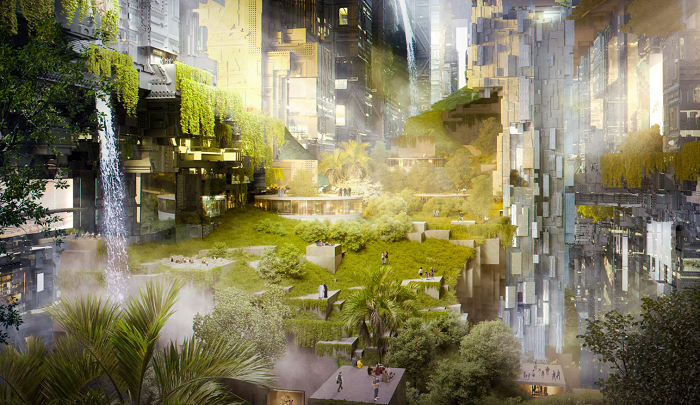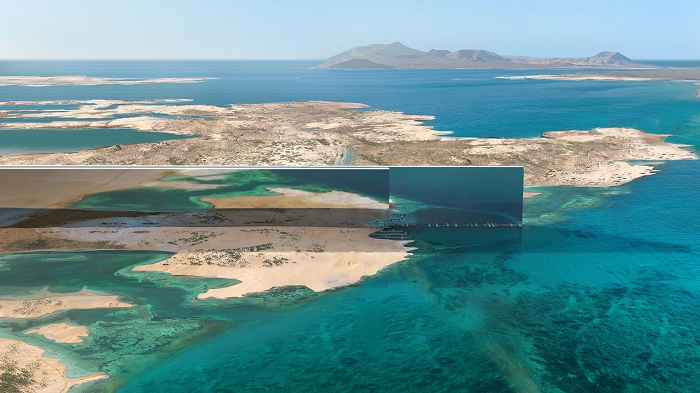ISABEL RUBIO ARROYO | Tungsteno
A futuristic city without roads, cars or emissions; while these features alone would make The Line surprising, its dimensions are most unusual: 170 kilometres long and 500 metres high by 200 metres wide. Having analysed the "ideal city" designed by Leonardo da Vinci, the floating islands to enlarge Manhattan, and a city run by artificial intelligence, we now turn to examine the feasibility of this ambitious project announced by the Crown Prince of Saudi Arabia, Mohammed bin Salman.
The dream of a city without pollution or accidents
The Line is supposed to be built in north-western Saudi Arabia, near the Red Sea, on an area of only about 34 square kilometres. "It will use less land when compared to other cities of similar capacity," say its creators. In theory, the city will run on 100% renewable energy and prioritise nature, health and wellbeing over transportation and infrastructure.
Salman insists that "we cannot ignore the environmental and livability crises facing our world's cities," and is committed to building "something as ambitious as Egypt’s pyramids." The solution its creators promise is an idyllic place, "without pollution and traffic accidents, coupled with world-class preventive healthcare, so people will live longer." They also intend to rely on a natural ventilation system to ensure that residents enjoy an ideal climate all year round.
The aim is for the city to house around nine million residents and create some 380,000 jobs by 2030. This proposal "challenges traditional flat, horizontal cities" by opting for the vertical construction of a towering skyscraper 500 metres high (which today would occupy 12th place on the list of the tallest buildings in the world) that stretches in a straight line along a length never before seen in a building and has mirrored facades. In theory, the facilities that residents will need to frequent on a day-to-day basis will be just a five-minute walk away and there will be a high-speed train that will run from one end of the city to the other in 20 minutes. "Not paying expenses such as car insurance, fuel and parking will mean more disposable income for citizens," its creators argue.
The aim is for The Line to house around nine million residents and create some 380,000 jobs by 2030. Credit: Neom.
Robot dinosaurs, an artificial moon and a lot of controversy
The Line is part of a much larger and even more ambitious project: a megacity called Neom, which is being built in Tabuk province and looks like something out of science fiction. In addition to flying taxis, its creators want it to house robot dinosaurs, cloud-seeding technology and a giant artificial moon. The project, with an initial investment of $500 billion, is not without controversy. Although its creators claim that Neom would be built on virgin land, in reality, some 20,000 people will be forced to relocate because of its construction. These residents belong to the Huwaitat tribe, which has been spread across Saudi Arabia, Jordan and the Sinai Peninsula for many generations.
"For the Huwaitat tribe, Neom is being built on our blood, on our bones," Alia Hayel Aboutiyah al-Huwaiti, a London-based activist and member of the tribe, told The Guardian. She sees it as a city for tourists and people with money: "It’s definitely not for the people already living there." For months, the tribe has been harassed, arrested and abducted by Saudi forces apparently because of their refusal to relocate to facilitate the Neom project, according to Al Jazeera.
In addition, expatriates recruited to work on the initiative criticise their managers for making unrealistic demands and turning a blind eye to discrimination, as reported in The Wall Street Journal. Among the employees who have resigned from the project or been fired are those who were poached from companies such as Walt Disney, Siemens AG and Marriott International. The controversy also prompted the video game company Riot Games to cut ties with the megacity's promoters and not accept sponsorship.

The Line will supposedly run on 100% renewable energy and prioritise nature, health and wellness. Credit: Neom.
Securing funding and other major challenges
For all the controversy surrounding this mega-project, many details about the construction and operation of The Line have yet to be made public. Behind the ambitious promises, there are many technical and economic challenges. Although Saudi Arabia is enjoying windfall revenues from high oil prices, it has not been very successful in attracting financial resources and investment from foreign governments and companies, according to The New Arab.
An initial assessment of the project, accessed by The Wall Street Journal, concludes that the city would have to be built in stages, which could take up to 50 years. In the assessment, Neom employees raise some concerns. For example, they note that after the pandemic, some people may not want to live in a high-rise environment. They also stress that the size of this giant skyscraper could alter the dynamics of groundwater flow in the desert wadis (a dry valley or river through which water only flows in the rainy season) and would restrict the movement of birds and other animals.
While it remains to be seen whether Saudi Arabia is able to meet these challenges, The Line is yet another example of the strong commitment of large nations to smart cities equipped with the latest technologies. It would not be the first time that the country has abandoned a vanity project. For example, during the last oil boom, it announced plans to build the world's tallest skyscraper, but the project was eventually put on hold. However, if it eventually succeeds in building The Line, one thing is clear: it will be a unique city in the world.
· — —
Tungsteno is a journalism laboratory to scan the essence of innovation. Devised by Materia Publicaciones Científicas for Sacyr’s blog.
